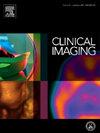Ultrasonographic appearance of Surgicel®: A systematic review
IF 1.8
4区 医学
Q3 RADIOLOGY, NUCLEAR MEDICINE & MEDICAL IMAGING
引用次数: 0
Abstract
Purpose
To perform a systematic review describing the most common ultrasonographic findings of the hemostatic agent Surgicel® and to identify different ultrasonographic patterns depending on ultrasound timing and localization of Surgicel®.
Method
A systematic literature search was performed to identify studies reporting ultrasonographic findings of Surgicel® according to the PRISMA guidelines. We queried PubMed, Web of Science, and Scopus using the terms “Surgicel®” OR “oxidized regenerated cellulose” AND “Ultrasound” from inception to march 2024. Patients with Surgicel® application during surgeries and posterior description of ultrasound features were included in the study. Risk of bias was evaluated with a modified standardized tool. (PROSPERO ID CRD42024542619).
Results
We found 464 articles, from which 12 articles were included, with a pooled population of 226 patients. Most rating as a moderate risk of bias. The predominant anatomical sites investigated were the breast and thyroid gland (94.68 %). The most frequent ultrasound appearance of Surgicel® was a hypo/isoechoic lesion with well-defined margins and internal hyperechoic nodules (49.11 %), followed by a hypo/isoechoic lesion with well-defined margins without internal hyperechoic nodules (18.58 %) and completely anechoic lesions (15.04 %). Hypo/isoechoic lesions with well-defined margins and internal hyperechoic nodules were frequent in the breast (55.56 %) and thyroid (53.49 %). Hyperechoic lesions with posterior reverberation artifact were consistently found in the liver, spleen, coronary vessels, and cervix (100 % each).
Conclusions
The most frequent ultrasound finding of Surgicel® was hypo/isoechoic lesions with well-defined margins and internal hyperechoic nodules. There may be distinct ultrasound characteristics of Surgicel® based on location. The impact of the type of organ, and timing of ultrasound remains to be defined.
求助全文
约1分钟内获得全文
求助全文
来源期刊

Clinical Imaging
医学-核医学
CiteScore
4.60
自引率
0.00%
发文量
265
审稿时长
35 days
期刊介绍:
The mission of Clinical Imaging is to publish, in a timely manner, the very best radiology research from the United States and around the world with special attention to the impact of medical imaging on patient care. The journal''s publications cover all imaging modalities, radiology issues related to patients, policy and practice improvements, and clinically-oriented imaging physics and informatics. The journal is a valuable resource for practicing radiologists, radiologists-in-training and other clinicians with an interest in imaging. Papers are carefully peer-reviewed and selected by our experienced subject editors who are leading experts spanning the range of imaging sub-specialties, which include:
-Body Imaging-
Breast Imaging-
Cardiothoracic Imaging-
Imaging Physics and Informatics-
Molecular Imaging and Nuclear Medicine-
Musculoskeletal and Emergency Imaging-
Neuroradiology-
Practice, Policy & Education-
Pediatric Imaging-
Vascular and Interventional Radiology
 求助内容:
求助内容: 应助结果提醒方式:
应助结果提醒方式:


